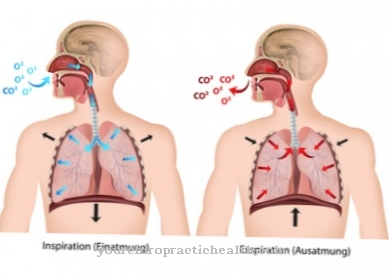The Complement system is part of the immune system. It consists of more than 30 proteins and is used to ward off bacteria, fungi and parasites.
What is the complement system?

The complement system was discovered by Jules Bordet, but the name goes back to Paul Ehrlich. The system consists of various plasma proteins. Plasma proteins are proteins that mostly circulate in the blood. However, a small proportion of plasma proteins is also present in cell-bound form.
The main components of the complement system are the complement factors C1 to C9, MBL (mannose-binding lectin) and the serine proteases that are bound to C1 and MBL. These are referred to as C1r, C1s, and MASP-1 through MASP-3. Most of the plasma proteins are produced in the liver. The complement factors C1 to C5 can be broken down by special protein-splitting enzymes, the proteases. This creates various new proteins. Further protein complexes arise from a combination of factors C1 to C5 with factors C6 to C9.
For regulation, the complement system has so-called negative regulators such as the C1 inhibitor or factor I. The complement system can be activated via the classic route, the lectin route and the alternative route. A cascade reaction is set in motion with each of these paths.
Function & task
The classic way to activate the complement system begins with the complement factor C1. C1 binds to an antigen-antibody complex. In this case, an antigen-antibody complex is a cell that is labeled with the antibodies IgG or IgM. When C1 binds to this complex, various reactions take place within the protein.
A subunit arises that activates the complement factor C4. The active components of C4, in turn, bind to C2. The complement factor C3 is activated from the combination of a subunit of C4 and C2. The activated C3 serves as a marker for so-called antigenic cells. This mark is also known as opsonization. The complement factor C3 shows the phagocytes (macrophages) that this marked cell is a cell that must be removed. Without this opsonization, the macrophages would not recognize many pathogens.
The C5 convertase is also formed from various subunits of complement factors. This ensures the activation of the complement factor C5. After activation, the factor is called C5b. C5b ensures the formation of a lytic complex. This destroys the cell membrane of the bacteria. Water can flow in through the holes that are created in the cell membrane, so that the bacteria ultimately burst.
The alternative complement activation does not require antibodies. The activation takes place here through a spontaneous decay of the complement factor C3. This is chemically unstable. The resulting C3a can initiate an inflammatory response. In addition to C3a, C3b is also created. C3b only remains active when it binds to pathogenic surfaces. If it circulates in the blood for too long or binds to the body's own cells, it is inactivated. This is important as it would otherwise lead to autoimmune reactions. On the surface of pathogens, C3b has a similar effect to C3 in the classic activation route.
MBL activation takes place through the binding of mannose. Mannose is sugar that is found on the surfaces of bacteria. In the course of the cascade reaction, MASP-1 to MASP-3 are activated. They evoke the same reactions as classic complement activation.
You can find your medication here
➔ Medicines to strengthen the defense and immune systemIllnesses & ailments
If there are deficiencies in the complement factors, various diseases can arise. A deficiency in the C1 inhibitor leads to an excessive reaction of the complement system. This deficiency can be congenital or acquired. Angioedema is the consequence of a C1 inhibitor deficiency. Swelling of the organs, the skin or the mucous membrane occurs again and again. This swelling is caused by excessive release of anaphylatoxins. The resulting edema is reddened and painful. They arise preferentially in the area of the lips, on the extremities or on the genitals. Swelling in the gastrointestinal tract can cause cramps and severe pain.
People with deficiencies in complement factor C2 are more likely to suffer from immune complex diseases. A lack of C1q, a precursor to C2, is a significant risk factor for the development of systemic lupus erythematosus (SLE). SLE is a rather rare autoimmune disease that affects the skin and other organs. The disease belongs to the group of collagenoses and thus also to the rheumatic type. Most of the time, women of childbearing age are affected by SLE.
If there is a lack of C3, bacterial infections are much more common. Infections with Neisseria in particular are increasing. Neisseria are the causative agents of gonorrhea and meningitis.
The inhibitory factor H may be missing due to a mutation. This leads to an uncontrollable activation of the complement system on the kidney corpuscles and the eye via the alternative route. The deposits cause the membranoproliferative glomerulonephritis type II. This leads to hematuria, proteinuria and a nephrotic or nephritic syndrome with water retention and high blood pressure. Visual disturbances are also possible.
If there are defects in the GPI anchors on blood cells, they are no longer protected from the complement system. This creates what is known as paroxysmal nocturnal hemoglobinuria. The red blood cells are destroyed. This process is also known as hemolysis. Furthermore, the disease is associated with an increased tendency to thrombosis and a reduced production of red blood cells in the bone marrow. Other symptoms are chronic fatigue, erectile dysfunction and severe pain. It is possible that not only the red blood cells but all blood cell rows are affected by the attacks of the complement system. In these cases, in addition to the tendency to thrombosis, there is also a significant weakening of the immune system.





.jpg)





















